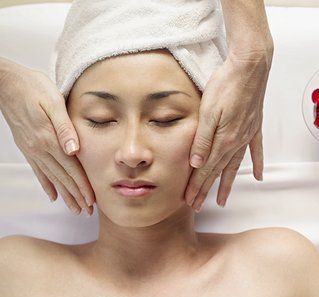Facial Reflexology – How Does It Work?
Reflexology is based on the basic premise that specific points on the body correspond to certain other specific other points or zones, and that application of pressure on the on the specified reflexes will result in improved circulation and other healing and health benefits.
It is by tapping the Qi in the body that these health benefits are brought about.
 Facial reflexology[1] is a particular branch of reflexology that looks to address all aspects of a person’s wellbeing, by working on the person’s most visible feature, the face.
Facial reflexology[1] is a particular branch of reflexology that looks to address all aspects of a person’s wellbeing, by working on the person’s most visible feature, the face.
The understanding behind face reflexology is that there are numerous nerve endings and a tracery of blood vessels in the face.
This fact coupled with the fact that the proximity of the face to the brain ensures quickest relay of sensory impulses is the reason that face reflexology is thought to be able to redress health imbalances, hormonal imbalances and menopausal issues, IPS, migraine, muscle tension etc.
Face reflexology seeks to address not only physical problems but also mental and emotional aspects of life and helps to improve energy levels.
The negative impacts of stress in everyday life, as well as behavioral and learning issues in children can be dealt with, using face reflexology, according to claims made as regard this alternative and complementary therapy.
Another result of face reflexology is that the improved blood circulation offers younger looking, smooth and glowing skin.
Specific points or zones on the face are stimulated in a therapeutic manner, which helps to improve blood circulation, which in turn improves nerve function, muscle tone and lymph drainage within the face.
Facial reflexology draws upon traditional wisdom as well as modern understanding of the way in which the systems of our body work.
This therapy has elements as diverse as Chinese energy meridians and acupressure points as well as South American and Vietnamese Body maps.
In addition it draws on modern disciplines such as Neuro-Anatomy, to help the therapist identify the imbalances that are present in the body, choosing the best combination to bring about results.
Facial reflexology makes use of acupressure points in the face to bring about results, and also, in other cases superimposes the foot reflexology map upon the face to align the chin and the heels, the toes and the forehead and so on to find the specific zones.
In yet other methods, the entire body is superimposed upon the face to help identify the points, such as the torso in alignment with the nose, the arms extended to form the arches of the brows and so on. These systems help to visualize and work on different body joints by working on the face.
Simply put, the reflex zones and points on the face are massaged to have certain beneficial impacts all over the body.
Specific problems such as depression, panic attacks, anxiety, gastric reflux, and indigestion have been seen to be alleviated by practitioners of facial reflexology.
After having administered 5 weekly treatment sessions some of these symptoms were seen to be greatly reduced and others had disappeared.
References
- ^ Facial reflexology (www.altmedicinezone.com)